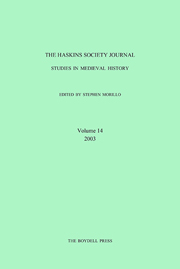Book contents
- Frontmatter
- Contents
- List of Illustrations
- Editorial Note
- Abbreviations
- 1 Even the Devil (Sometimes) has Feelings: Emotional Communities in the Early Middle Ages
- 2 Alcuin, Willibrord, and the Cultivation of Faith
- 3 Henry Loyn Memorial Lecture: English Identity from Bede to the Millennium
- 4 The ‘Farm of One Night’ and the Organisation of Royal Estates in Late Anglo-Saxon Wessex
- 5 Changing Fortunes: Edwardian Anglo-Jewry and their Credit Operations in Late Thirteenth-Century England
- 6 Forty Acres and a Mule: the Mechanics of English Settlement in Northeast Wales after the Edwardian Conquest
- 7 Consanguinity and the Saint-Aubin Genealogies
- 8 Widows, Religious Patronage and Family Identity: Some Cases from Twelfth-Century Yorkshire
- 9 Desecration and Consecration in Norman Capua, 1062–1122: Contesting Sacred Space during the Gregorian Reforms
- 10 From Ego to Imago: Mediation and Agency in Medieval France (1000–1250)
3 - Henry Loyn Memorial Lecture: English Identity from Bede to the Millennium
Published online by Cambridge University Press: 05 September 2014
- Frontmatter
- Contents
- List of Illustrations
- Editorial Note
- Abbreviations
- 1 Even the Devil (Sometimes) has Feelings: Emotional Communities in the Early Middle Ages
- 2 Alcuin, Willibrord, and the Cultivation of Faith
- 3 Henry Loyn Memorial Lecture: English Identity from Bede to the Millennium
- 4 The ‘Farm of One Night’ and the Organisation of Royal Estates in Late Anglo-Saxon Wessex
- 5 Changing Fortunes: Edwardian Anglo-Jewry and their Credit Operations in Late Thirteenth-Century England
- 6 Forty Acres and a Mule: the Mechanics of English Settlement in Northeast Wales after the Edwardian Conquest
- 7 Consanguinity and the Saint-Aubin Genealogies
- 8 Widows, Religious Patronage and Family Identity: Some Cases from Twelfth-Century Yorkshire
- 9 Desecration and Consecration in Norman Capua, 1062–1122: Contesting Sacred Space during the Gregorian Reforms
- 10 From Ego to Imago: Mediation and Agency in Medieval France (1000–1250)
Summary
English identity in the early Middle Ages might seem an insensitive topic for an Englishman to choose as the first of a series of lectures in Cardiff. But the subject was, of course, central to the interests of Henry Loyn. Though a Welshman born in Cardiff, educated here and for most of his career employed here too, Henry always delighted in English literature and the English language; he also concentrated much of his teaching and the majority of his researches upon English history. In his honour, therefore, I seek to survey how far the Anglo-Saxon peoples of Britain thought of themselves as a single people of common descent, customs and language in the centuries between the writing of Bede's Ecclesiastical History of the English People and AD 1000, the end of the first millennium. By that time a kingdom of the English had – so it proved – been effectively established. I shall necessarily hasten over the centuries, but will alight upon and analyse in some detail those authors and sources that seem to me of particular significance. I shall not attempt to explore the issue, which the scarcity of early medieval sources makes problematic, of how widely particular ethnic identities may have been held in society. I am not attempting to prove or to disprove the existence of early medieval English nationalism. I rather seek to understand the development of, and pressures upon, the concept of English identity in this period.
- Type
- Chapter
- Information
- The Haskins Society Journal 142003. Studies in Medieval History, pp. 33 - 52Publisher: Boydell & BrewerPrint publication year: 2005

